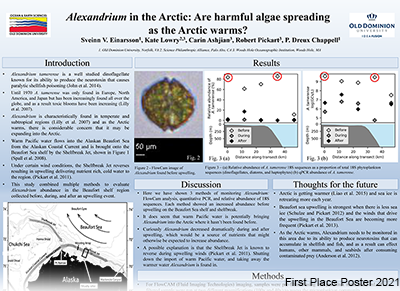College
College of Sciences
Department
Ocean/Earth/Atmos Sciences
Program
Ocean and Earth Sciences, M.S.
Publication Date
4-2021
DOI
10.25883/0r89-2q28
Abstract
The Arctic Ocean is a rapidly changing environment, and a key observational system for monitoring climate change. The Arctic is going under a rapid transition from thicker, multi-year ice, to thinner first-year ice, that may have many potential consequences. As first year Arctic sea ice begins to retreat in the spring and early summer, melting snow and ice form ponds on the surface- “melt ponds”. These melt ponds increase light transmission to the water column, resulting in warming and increased primary production under the ice. Recent advances in high resolution satellite imagery now allow us to monitor the development and propagation of melt ponds from space. 14 Worldview images (privately owned) of first year ice in the Chukchi Sea with sub-meter scale spatial resolution were recorded from June and July 2018 and classified into 4 distinct classes- Un-ponded Ice, Dark Melt Pond, Light Melt Pond, and Open Water. Classification data were analyzed for melt pond abundance (pond fraction) and size. Pond growth can be described by either a linear or logistic growth function (r2 = 0.86). Additionally, previously recorded light transmission values can be used to create an under-ice light availability budget based on class distribution data. This allows for estimates of primary production and the prediction of below ice phytoplankton blooms. As the Arctic continues to experience an extreme regime shift, increased monitoring of melt ponds and other rapidly changing systems will be essential
Keywords
Arctic, Satellite, Oceanography, Ice, Biology
Disciplines
Climate | Oceanography | Spatial Science
Files
Download Full Text (1.6 MB)
Recommended Citation
Abbott, Austin and Hill, Victoria, "Examining Arctic Melt Pond Dynamics via High Resolution Satellite Imagery" (2021). College of Sciences Posters. 12.
https://digitalcommons.odu.edu/gradposters2021_sciences/12



